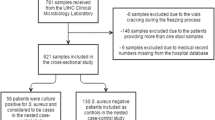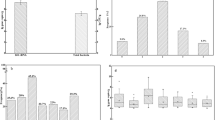Abstract
Coagulase-negative staphylococci (CoNS) are the most prevalent pathogens causing late-onset sepsis in neonates. The question is whether neonates acquire endemic hospital-adapted clones or incidentally occurring CoNS strains after birth during their hospital stay. Therefore, a prospective study was performed on the prevalence of CoNS in the stool of babies (born vaginally or by cesarean section) during their first days of life. Their clonal relatedness and potential to induce invasive disease were characterized. CoNS were analyzed from the stool samples of newborns with a load of CoNS above 103 colony-forming units (CFU)/mL. The identification of CoNS was performed phenotypically and genotypically. For typing, repetitive polymerase chain reaction (PCR), pulsed-field gel electrophoresis, and multilocus sequence typing were used. Resistance profiles, biofilm production, the presence of icaAD and of IS256 were determined as well. From a total of 207 stool samples (56 newborns), CoNS were detected in 41% of the newborns, mostly on day 3 for the first time (62.5%). Staphylococcus epidermidis was isolated in 85.7% of cases, harbored no IS256 element, and mostly expressed no biofilm. The isolates were separated into four main clusters by repetitive sequence-based PCR. 24% of the strains showed no antimicrobial resistance. 20% were resistant against four antibiotics of two different antibiotic classes. The remaining strains were resistant only against one antimicrobial substance class. Thus, it can be concluded that newborns do not acquire hospital-adapted endemic, multidrug-resistant S. epidermidis isolates during their first days of life. Yet, the results support the thesis that, during hospital stay, environmental parameters may convert sensible/noninvasive S. epidermidis strains into multidrug-resistant strains with characteristics of invasiveness.




Similar content being viewed by others
References
Aas JA, Paster BJ, Stokes LN, Olsen I, Dewhirst FE (2005) Defining the normal bacterial flora of the oral cavity. J Clin Microbiol 43:5721–5732
Widerström M (2016) Significance of Staphylococcus epidermidis in health care-associated infections, from contaminant to clinically relevant pathogen: this is a wake-up call! J Clin Microbiol 54(7):1679–1681
Cortese F, Scicchitano P, Gesualdo M et al (2016) Early and late infections in newborns: where do we stand? A review. Pediatr Neonatol 57:265–273
Sakata H, Yoshioka H, Fujita K (1985) Development of the intestinal flora in very low birth weight infants compared to normal full-term newborns. Eur J Pediatr 144:186–190
Marchant EA, Boyce GK, Sadarangani M, Lavoie PM (2013) Neonatal sepsis due to coagulase-negative staphylococci. Clin Dev Immunol. Volume 2013, Article ID 586076. doi:10.1155/2013/586076
Cherifi S, Byl B, Deplano A, Nonhoff C, Denis O, Hallin M (2013) Comparative epidemiology of Staphylococcus epidermidis isolates from patients with catheter-related bacteremia and from healthy volunteers. J Clin Microbiol 51(5):1541–1547
Galdbart JO, Allignet J, Tung HS, Rydèn C, El Solh N (2000) Screening for Staphylococcus epidermidis markers discriminating between skin-flora strains and those responsible for infections of joint prostheses. J Infect Dis 182:351–355
van Belkum A, Kluytmans J, van Leeuwen W et al (1995) Multicenter evaluation of arbitrarily primed PCR for typing of Staphylococcus aureus strains. J Clin Microbiol 33:1537–1547
Shutt CK, Pounder JI, Page SR, Schaecher BJ, Woods GL (2005) Clinical evaluation of the DiversiLab microbial typing system using repetitive-sequence-based PCR for characterization of Staphylococcus aureus strains. J Clin Microbiol 43:1187–1192
Geary C, Jordens JZ, Richardson JF, Hawcroft DM, Mitchell CJ (1997) Epidemiological typing of coagulase-negative staphylococci from nosocomial infections. J Med Microbiol 46:195–203
Rohde H, Kalitzky M, Kröger N et al (2004) Detection of virulence-associated genes not useful for discriminating between invasive and commensal Staphylococcus epidermidis strains from a bone marrow transplant unit. J Clin Microbiol 42:5614–5619
Galdbart JO, Morvan A, Desplaces N, el Solh N (1999) Phenotypic and genomic variation among Staphylococcus epidermidis strains infecting joint prostheses. J Clin Microbiol 37:1306–1312
Bradford R, Manan RA, Daley AJ et al (2006) Coagulase-negative staphylococci in very-low-birth-weight infants: inability of genetic markers to distinguish invasive strains from blood culture contaminants. Eur J Clin Microbial Infect Dis 25:283–290
Layer F, Ghebremedhin B, König W, König B (2007) Differentiation of Staphylococcus spp. by terminal-restriction fragment length polymorphism analysis of glyceraldehyde-3-phosphate dehydrogenase-encoding gene. J Microbiol Methods 70:542–549
Handke LD, Conlon KM, Slater SR et al (2004) Genetic and phenotypic analysis of biofilm phenotypic variation in multiple Staphylococcus epidermidis isolates. J Med Microbiol 53:367–374
Kozitskaya S, Cho SH, Dietrich K, Marre R, Naber K, Ziebuhr W (2004) The bacterial insertion sequence element IS256 occurs preferentially in nosocomial Staphylococcus epidermidis isolates: association with biofilm formation and resistance to aminoglycosides. Infect Immun 72:1210–1215
Gevers D, Huys G, Swings J (2001) Applicability of rep-PCR fingerprinting for identification of Lactobacillus species. FEMS Microbiol Lett 205:31–36
Layer F, Ghebremedhin B, Moder KA, König W, König B (2006) Comparative study using various methods for identification of Staphylococcus species in clinical specimens. J Clin Microbiol 44:2824–2830
Ghebremedhin B, Layer F, König W, König B (2008) Genetic classification and distinguishing of Staphylococcus species based on different partial gap, 16S rRNA, hsp60, rpoB, sodA, and tuf gene sequences. J Clin Microbiol 46:1019–1025
Thomas JC, Vargas MR, Miragaia M, Peacock SJ, Archer GL, Enright MC (2007) Improved multilocus sequence typing scheme for Staphylococcus epidermidis. J Clin Microbiol 45:616–619
Christensen GD, Simpson WA, Bisno AL, Beachey EH (1982) Adherence of slime-producing strains of Staphylococcus epidermidis to smooth surfaces. Infect Immun 37:318–326
Wojtyczka RD, Orlewska K, Kępa M et al (2014) Biofilm formation and antimicrobial susceptibility of Staphylococcus epidermidis strains from a hospital environment. Int J Environ Res Public Health 11(5):4619–4633
Jiménez E, Delgado S, Maldonado A et al (2008) Staphylococcus epidermidis: a differential trait of the fecal microbiota of breast-fed infants. BMC Microbiol 8:143–145
Delgado S, Arroyo R, Jiménez E et al (2009) Staphylococcus epidermidis strains isolated from breast milk of women suffering infectious mastitis: potential virulence traits and resistance to antibiotics. BMC Microbiol 9:82–93
Wieser M, Busse HJ (2000) Rapid identification of Staphylococcus epidermidis. Int J Syst Evol Microbiol 50:1087–1093
Melles DC, Gorkink RF, Boelens HAM et al (2004) Natural population dynamics and expansion of pathogenic clones of Staphylococcus aureus. J Clin Invest 114:1732–1740
Mendes RE, Deshpande LM, Costello AJ, Farrell DJ (2012) Molecular epidemiology of Staphylococcus epidermidis clinical isolates from U.S. hospitals. Antimicrob Agents Chemother 56(9):4656–4661
Koskela A, Nilsdotter-Augustinsson A, Persson L, Söderquist B (2009) Prevalence of the ica operon and insertion sequence IS256 among Staphylococcus epidermidis prosthetic joint infection isolates. Eur J Clin Microbiol Infect Dis 28:655–660
Du X, Zhu Y, Song Y et al (2013) Molecular analysis of Staphylococcus epidermidis strains isolated from community and hospital environments in China. PLoS One 8(5):e62742. doi:10.1371/journal.pone.0062742
Bogado I, Limansky A, Sutich E et al (2002) Molecular characterization of methicillin-resistant coagulase-negative staphylococci from a neonatal intensive care unit. Infect Control Hosp Epidemiol 23:447–451
Yazdankhah SP, Asli AW, Sørum H, Oppegaard H, Sunde M (2006) Fusidic acid resistance, mediated by fusB, in bovine coagulase-negative staphylococci. J Antimicrob Chemother 58:1254–1256
Villari P, Sarnataro C, Iacuzio L (2000) Molecular epidemiology of Staphylococcus epidermidis in a neonatal intensive care unit over a three-year period. J Clin Microbiol 38:1740–1746
Nowakowska M, Rudy M, Zientara M et al (2004) Intestinal colonization of newborns treated in intensive care units by multiple drug resistant microorganisms. Med Dosw Mikrobiol 56:301–308
Li H, Xu L, Wang J et al (2005) Conversion of Staphylococcus epidermidis strains from commensal to invasive by expression of the ica locus encoding production of biofilm exopolysaccharide. Infect Immun 73:3188–3191
Acknowledgments
The authors wish to acknowledge Prof. Dr. h.c. SD Costa, Department of Obstetrics and Gynecology, University of Magdeburg, for support and for the assistance in data collection.
Author information
Authors and Affiliations
Contributions
BK has made substantial contributions to the conception and design of the study, the sample collection, analysis, and statistical analysis and interpretation of the data. FL and SW participated in the sample collection, analysis, and interpretation of the data. SFM was involved in the data collection and drafting the manuscript. BS-G has critically revised the manuscript and added important intellectual content. WK has been substantially involved in the designing of the study. MW participated in the drafting of the manuscript and gave final approval of the version to be published. All authors read and approved the final manuscript.
Corresponding author
Ethics declarations
Data availability
The datasets analyzed during the current study are available from BK on reasonable request (Brigitte.Koenig@medizin.uni-leipzig.de).
Ethical approval
All procedures performed in studies involving human participants were in accordance with the ethical standards of the institutional and/or national research committee and with the 1964 Helsinki declaration and its later amendments or comparable ethical standards.
Conflict of interest
The authors declare that the research was conducted in the absence of any commercial or financial relationships that could be construed as a potential conflict of interest.
Rights and permissions
About this article
Cite this article
Fill Malfertheiner, S., Wendt, S., Layer, F. et al. Prevalence, clonality, and pathogenicity of Staphylococcus epidermidis isolates in newborn feces. Eur J Clin Microbiol Infect Dis 36, 1955–1964 (2017). https://doi.org/10.1007/s10096-017-3019-3
Received:
Accepted:
Published:
Issue Date:
DOI: https://doi.org/10.1007/s10096-017-3019-3




